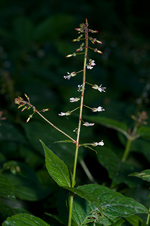|
||||||
|
CIRCAEA. Enchanter's-nightshade. [Onagraceae] |
|
|
Three species of Circaea are recorded in Britain. These include Enchanter's-nightshade (C. lutetiana). Two British miners are recorded on Circaea. A key to the European miners recorded on Circaea is provided in Bladmineerders van Europa. |
 Enchanter's-nightshade Circaea lutetiana |
|
Key for the identification of the known mines of British |
1a > Leaf-miner: A narrow contorted gallery leading to a whitish blotch with scattered frass centrally. The early gallery can merge with the blotch and there are often several to a leaf (British leafminers). The larva begins by making a full depth corridor, erratic in width and course; frass black, in an irregular central line. Later the larva makes a blotch, with frass in irregular clouds. This blotch can be a continuation of the corridor, but may just as well be on a different leaf. Often several mines in a leaf; in such cases the entire leaf me be mined out. Mines white at first, turning brown later. The larva lies venter-upwards in the mine. Larvae light yellow, with darker thoracic legs (British leafminers). The larva is also illustrated in Bladmineerders van Europa. Pupation external Bladmineerders van Europa). |
|
Mompha langiella (Hübner, 1796) [Lepidoptera: Momphidae]. |
1b > Leaf-miner: Early mines are spiral galleries; later forms pale blotches, sometimes having moved to a different leaf. Egg at the upperside of the leaf, not near the midrib. The larva starts by making a long, narrow, full depth corridor that is strongly spiraled or even lies in intestine-like loops. Frass as fine grains, distributed, later in a central line. After a while a new mine is made, either a continuation of the corridor or, more often, in a new leaf. This new mine begins as a narrow corridor but soon widens into a large blotch; here the fass lies in a broad band.The larvae of moths have a head capsule and chewing mouthparts with opposable mandibles (see video of a gracillarid larva feeding), six thoracic legs and abdominal legs (see examples). Larvae hitish; head light brown; prothoracic and anal shield yellowish brown (Koster, 2002b; Koster and Sinev, 2003a) (Bladmineerders van Europa). Pupation in a cocoon, on a leaf or in leaf-litter (British leafminers). See also See Patočka and Turčáni (2005a) (Bladmineerders van Europa). |
|
Mompha terminella (Humphreys & Westwood, 1845) [Lepidoptera: Momphidae]. |
| Last updated 31-Aug-2019 Brian Pitkin | ||
